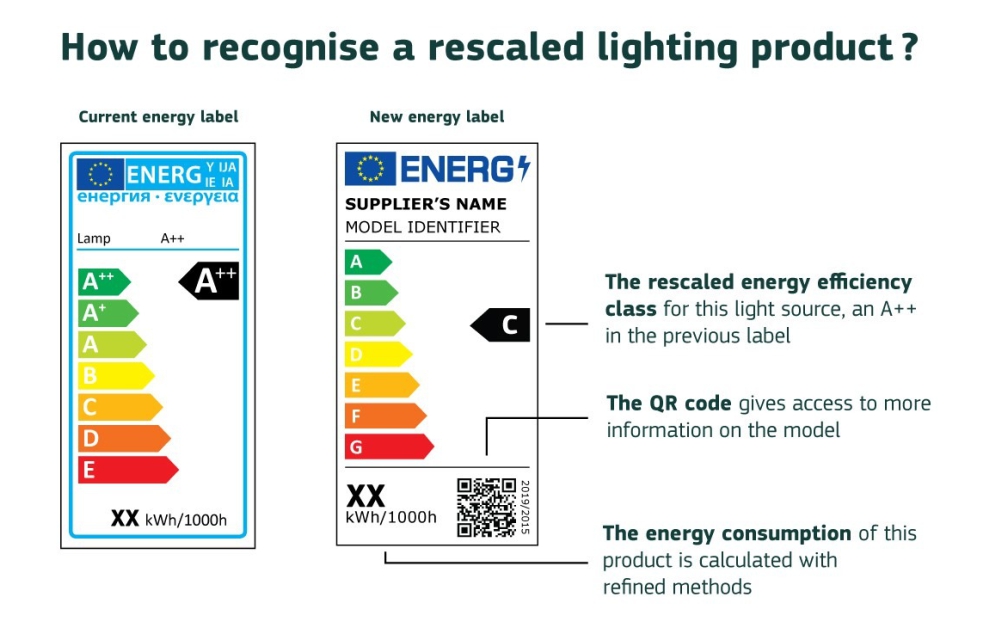You may have noticed that there were some changes introduced light bulb’s energy labels in 2021.
Since 1st September 2021, the energy labels that tell us how energy-efficient a light bulb is have started to transition into a new system. This new system will be fully in place by 1st March 2023.
The alterations were triggered by the new EU 2019/2020 Single Lighting Regulation (SLR) and the new EU 2019/2015 Energy Label Regulation (ELR). The changes are designed to protect the environment further, boost consumer protection and improve the sustainability of products. The new regulations have been incorporated into UK law under The Ecodesign for Energy-Related Products and Energy Information (Lighting Products) Regulations 2021 2021 No. 1095.
New Energy Rating Scale
Based on the energy efficiency achieved, each light source will be given a new classification and a new rating between A and G. In addition to this, some products will not be permitted to be placed on the market in the EU. Please note that existing stock with the old label may still be sold until 1 March 2023.
New LED light bulbs are becoming more and more energy-efficient. Almost all new LED products are labelled in the top categories (A++, A+, A). Rather than adding more plusses to the A class, the new letters have been “rescaled”, to a simpler A to G scale.
Although the energy rating scale has changed, the product itself is still the same and will still consume the same amount of energy. This also means the light bulb will cost the same to run as it ever did
This new, simpler system will not only make it easier to know which light bulbs are the most energy-efficient, but it will also allow more room for innovation. That’s because the current most efficient light bulbs will now be rated as an F or a G in the new rankings, meaning manufacturers have more opportunity to build even more efficient light bulbs in the future.
Labelling: the alternative
From September 1, 2021, and in accordance with the new energy labelling regulations, all EU light sources must be listed in the EPREL database (European Product Database for Energy Labelling) or (for UK products) the manufacturers specification information where they will be assessed and relabelled on the basis of ecological and sustainable aspects.
The QR code on the label links to data stored in the EPREL database/UK manufacturers specifications. By scanning the QR code featured on the new energy labels you can access information such as the luminous flux, the colour temperature and the cap type.

What’s on the new energy labels?
1,All light sources are evaluated in accordance with the regulations
2,The packaging and graphics you see will have been adapted slightly
3,All light sources are included in the EU wide EPREL database
4,There’s a brand new energy efficiency label. The scale has changed from “A++ to E” to “A to G“.
5,Existing stock can be sold without reclassification until March 2023.
Why has a new energy label been introduced?
In recent years, you may have noticed that electrical appliances and light sources have become more and more energy-efficient. Because of this, most appliances were considered efficient and there were hardly any differences between the energy efficiency ratings A+, A++ and A+++. The new energy label has been introduced to make the differences far clearer.
What are the differences to the old energy label?
A+, A++ und A+++ ratings no longer exist on the new EU energy label. The new scale runs from A to G. We explain about rating A further down this blog, but for now ratings B and C are the ‘best in class’ and most energy-efficient lights. You may have noticed the QR code which is also new. This gives the customers direct access to the European Product Database for Energy Labelling (EPREL), in which further product information is available. This registration is mandatory for manufacturers.
Can I compare old and new energy labels?
The efficiency rating is new and therefore cannot be compared to the old label. For example, the external power supply will be added to the energy consumption in the future, which will lower the overall efficiency.
It’s also worth remembering, light sources with energy class A do not exist for the time being. This type of energy class is on hold and will rate even more energy-efficient appliances with new technologies in the future.
Are lights with the new energy label less efficient?
No. They are still the same energy-efficient light as before – only the designated letter has changed. The new test procedure is incredibly stringent and also considers future lighting efficiency improvements. In short, the efficient products under the old energy label are just as efficient with the new one.
Do all appliances have the new EU energy label?
Most electrical appliances that you will now see, have an old EU energy label and a new one. In addition to light sources, these include, things like TVs and home appliances, such as washing machines and refrigerators.
If you have any questions regarding the EU regulation of LED lighting products like test standard or new ErP, then get in touch with us, our team will be glad to help you.
Creating a comfortable and inviting home environment starts with the right lighting. Here are some e...
Learn more >Finding the right lighting for reading can significantly enhance your experience and protect your ey...
Learn more >The invention of LED lights has transformed how we illuminate our lives. Understanding the history o...
Learn more >